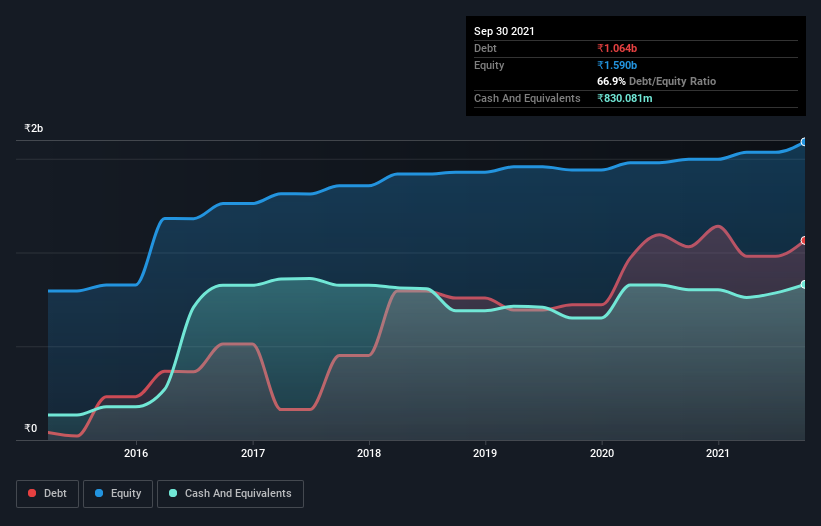IntraSoft Technologies (NSE:ISFT) Has A Pretty Healthy Balance Sheet
David Iben put it well when he said, 'Volatility is not a risk we care about. What we care about is avoiding the permanent loss of capital.' It's only natural to consider a company's balance sheet when you examine how risky it is, since debt is often involved when a business collapses. We can see that IntraSoft Technologies Limited (NSE:ISFT) does use debt in its business. But the more important question is: how much risk is that debt creating?
What Risk Does Debt Bring?
Debt is a tool to help businesses grow, but if a business is incapable of paying off its lenders, then it exists at their mercy. If things get really bad, the lenders can take control of the business. While that is not too common, we often do see indebted companies permanently diluting shareholders because lenders force them to raise capital at a distressed price. Of course, plenty of companies use debt to fund growth, without any negative consequences. When we think about a company's use of debt, we first look at cash and debt together.
Check out our latest analysis for IntraSoft Technologies
What Is IntraSoft Technologies's Net Debt?
The chart below, which you can click on for greater detail, shows that IntraSoft Technologies had ₹1.06b in debt in September 2021; about the same as the year before. However, it also had ₹830.1m in cash, and so its net debt is ₹234.2m.

How Strong Is IntraSoft Technologies' Balance Sheet?
Zooming in on the latest balance sheet data, we can see that IntraSoft Technologies had liabilities of ₹349.7m due within 12 months and liabilities of ₹1.10b due beyond that. Offsetting this, it had ₹830.1m in cash and ₹38.8m in receivables that were due within 12 months. So its liabilities total ₹583.7m more than the combination of its cash and short-term receivables.
Given IntraSoft Technologies has a market capitalization of ₹3.52b, it's hard to believe these liabilities pose much threat. But there are sufficient liabilities that we would certainly recommend shareholders continue to monitor the balance sheet, going forward.
We measure a company's debt load relative to its earnings power by looking at its net debt divided by its earnings before interest, tax, depreciation, and amortization (EBITDA) and by calculating how easily its earnings before interest and tax (EBIT) cover its interest expense (interest cover). This way, we consider both the absolute quantum of the debt, as well as the interest rates paid on it.
IntraSoft Technologies has net debt worth 2.4 times EBITDA, which isn't too much, but its interest cover looks a bit on the low side, with EBIT at only 6.0 times the interest expense. While that doesn't worry us too much, it does suggest the interest payments are somewhat of a burden. Pleasingly, IntraSoft Technologies is growing its EBIT faster than former Australian PM Bob Hawke downs a yard glass, boasting a 250% gain in the last twelve months. There's no doubt that we learn most about debt from the balance sheet. But it is IntraSoft Technologies's earnings that will influence how the balance sheet holds up in the future. So when considering debt, it's definitely worth looking at the earnings trend. Click here for an interactive snapshot.
Finally, a company can only pay off debt with cold hard cash, not accounting profits. So it's worth checking how much of that EBIT is backed by free cash flow. During the last three years, IntraSoft Technologies burned a lot of cash. While that may be a result of expenditure for growth, it does make the debt far more risky.
Our View
IntraSoft Technologies's conversion of EBIT to free cash flow was a real negative on this analysis, although the other factors we considered were considerably better. In particular, we are dazzled with its EBIT growth rate. When we consider all the factors mentioned above, we do feel a bit cautious about IntraSoft Technologies's use of debt. While we appreciate debt can enhance returns on equity, we'd suggest that shareholders keep close watch on its debt levels, lest they increase. When analysing debt levels, the balance sheet is the obvious place to start. However, not all investment risk resides within the balance sheet - far from it. For example IntraSoft Technologies has 5 warning signs (and 1 which is a bit unpleasant) we think you should know about.
At the end of the day, it's often better to focus on companies that are free from net debt. You can access our special list of such companies (all with a track record of profit growth). It's free.
New: AI Stock Screener & Alerts
Our new AI Stock Screener scans the market every day to uncover opportunities.
• Dividend Powerhouses (3%+ Yield)
• Undervalued Small Caps with Insider Buying
• High growth Tech and AI Companies
Or build your own from over 50 metrics.
Have feedback on this article? Concerned about the content? Get in touch with us directly. Alternatively, email editorial-team (at) simplywallst.com.
This article by Simply Wall St is general in nature. We provide commentary based on historical data and analyst forecasts only using an unbiased methodology and our articles are not intended to be financial advice. It does not constitute a recommendation to buy or sell any stock, and does not take account of your objectives, or your financial situation. We aim to bring you long-term focused analysis driven by fundamental data. Note that our analysis may not factor in the latest price-sensitive company announcements or qualitative material. Simply Wall St has no position in any stocks mentioned.
About NSEI:ISFT
IntraSoft Technologies
Through its subsidiaries, engages in the development and delivery of e-commerce and e-cards through internet platform in India and internationally.
Flawless balance sheet and good value.
Market Insights
Community Narratives




